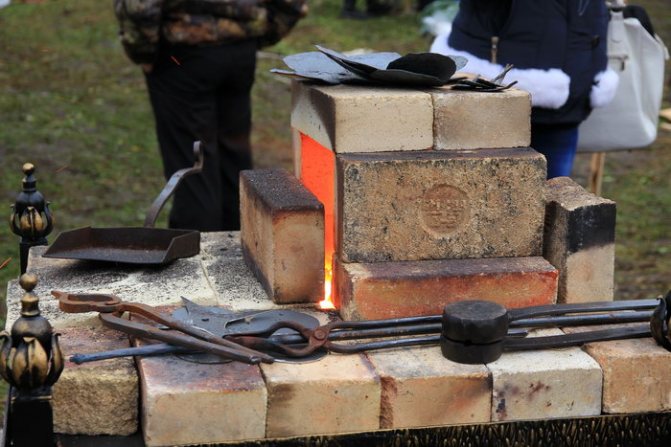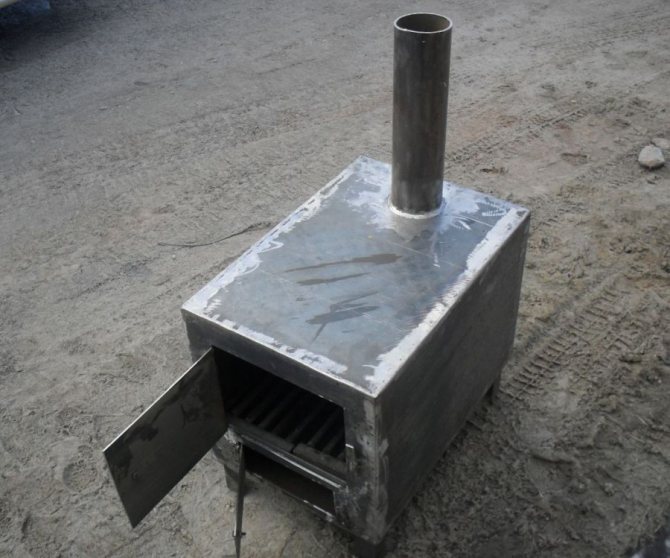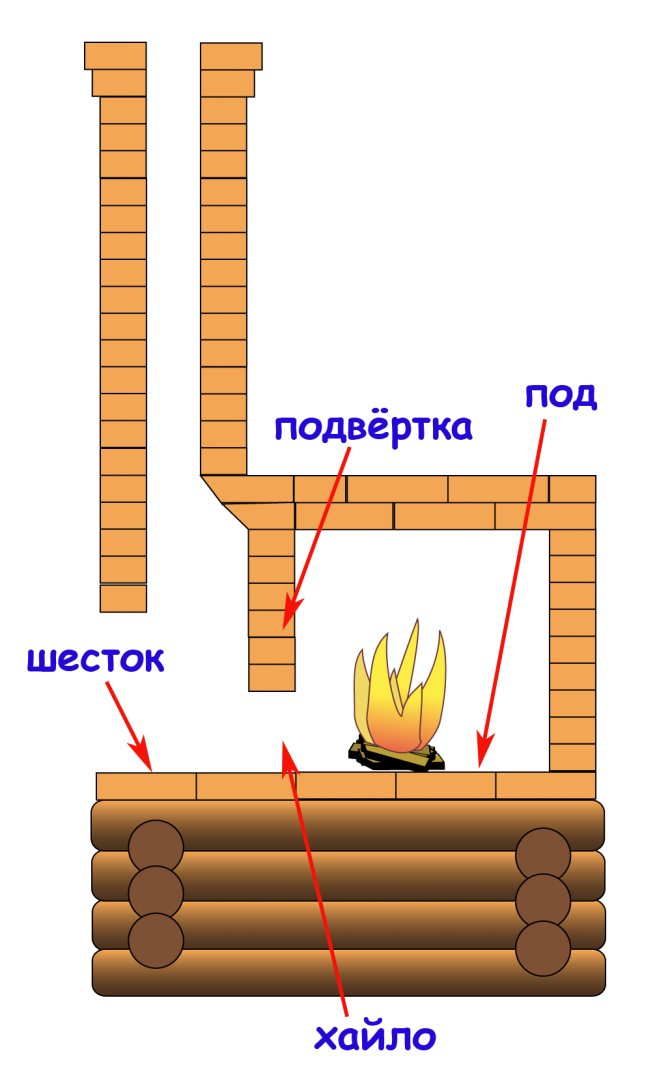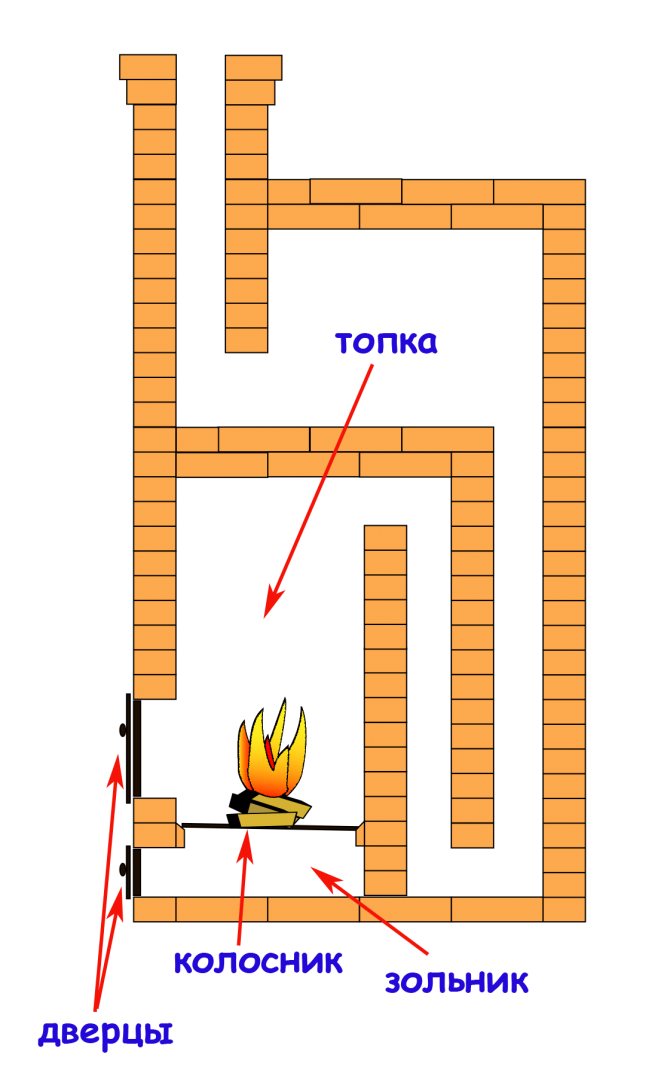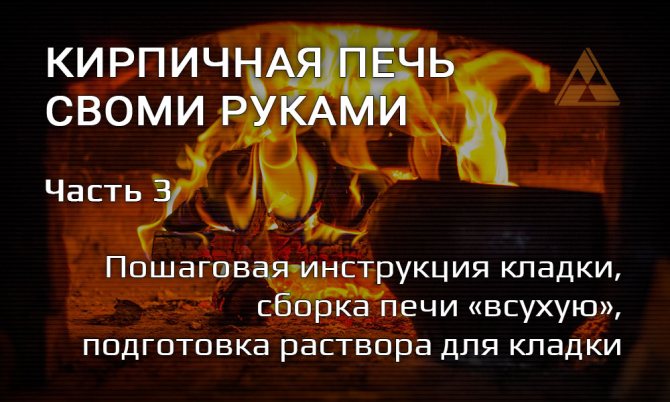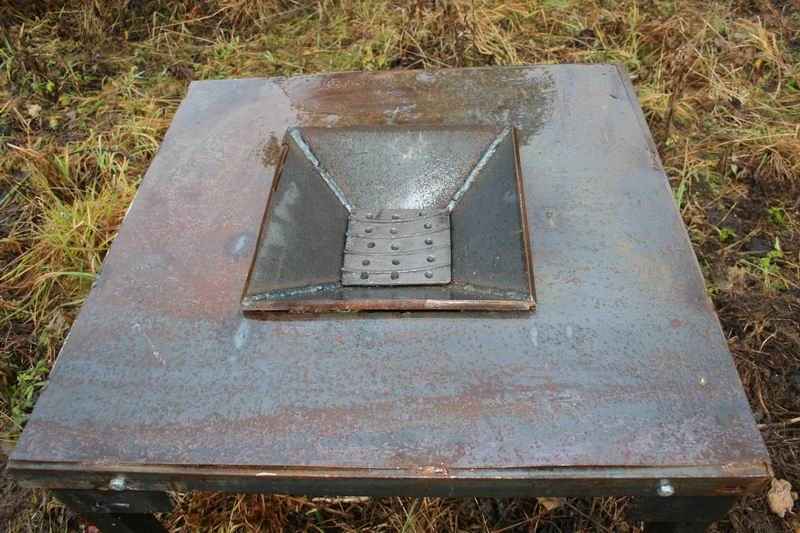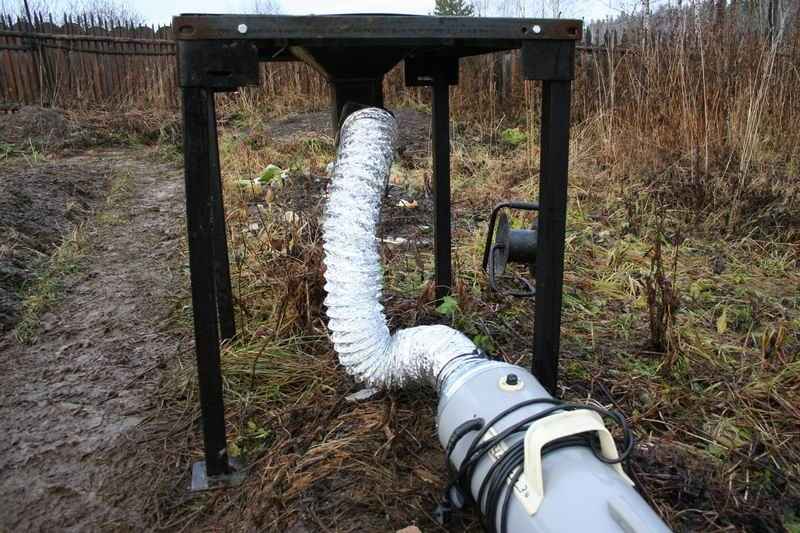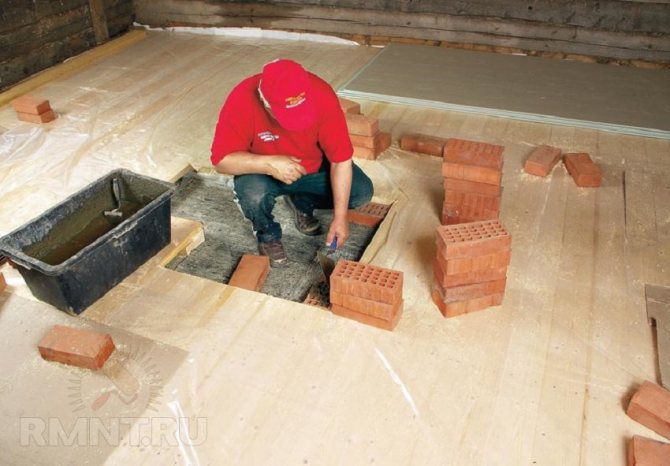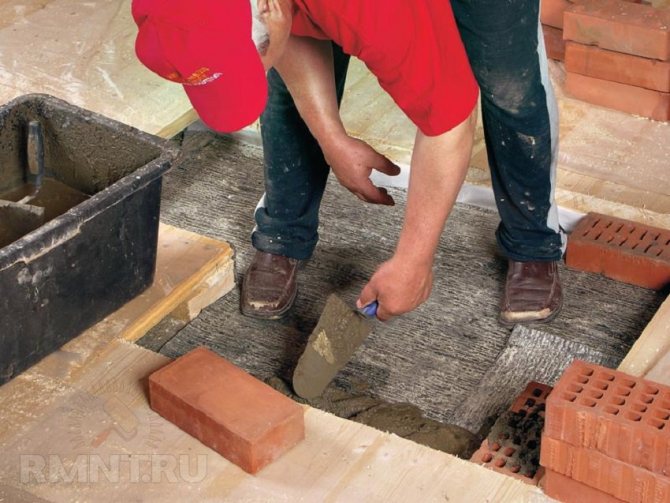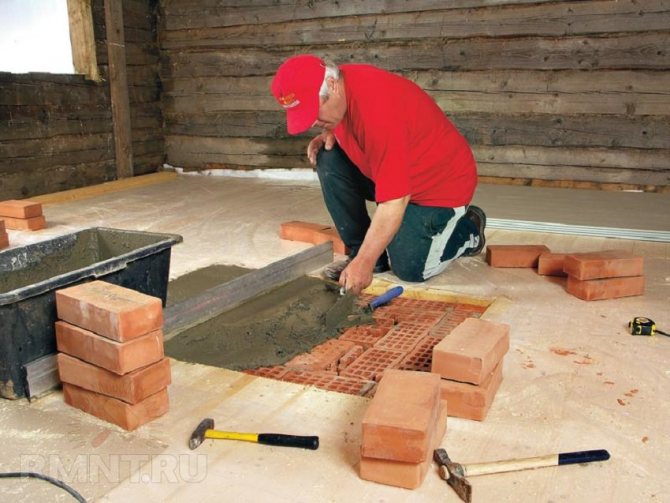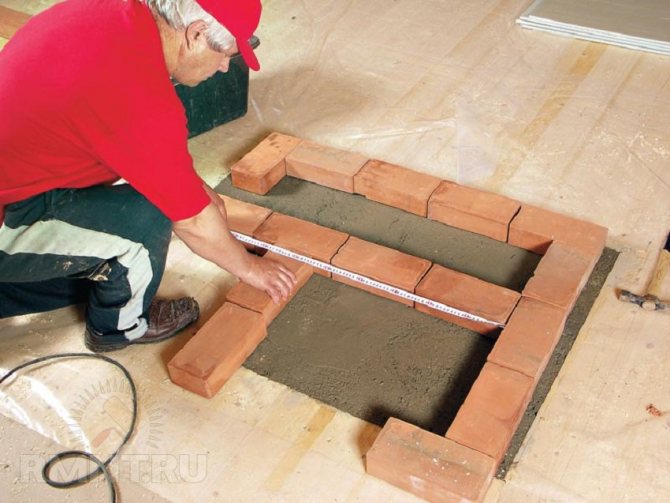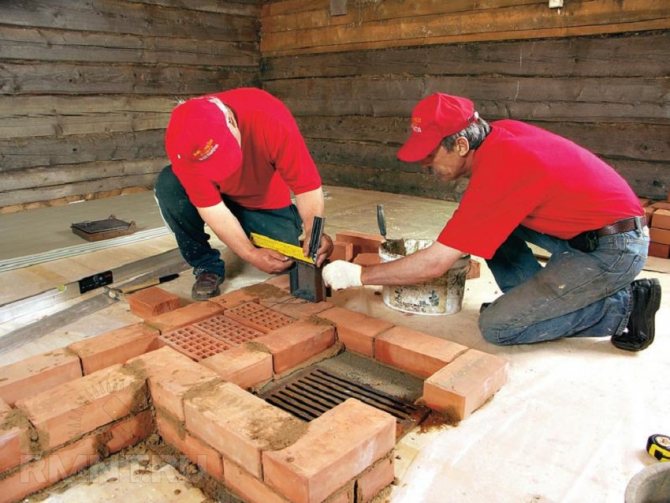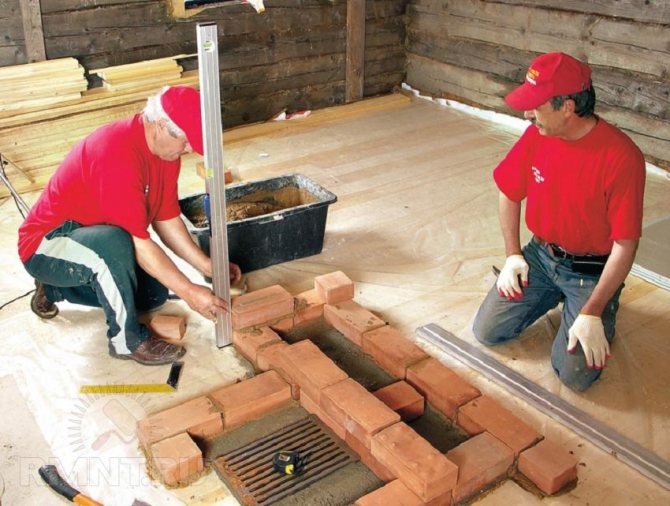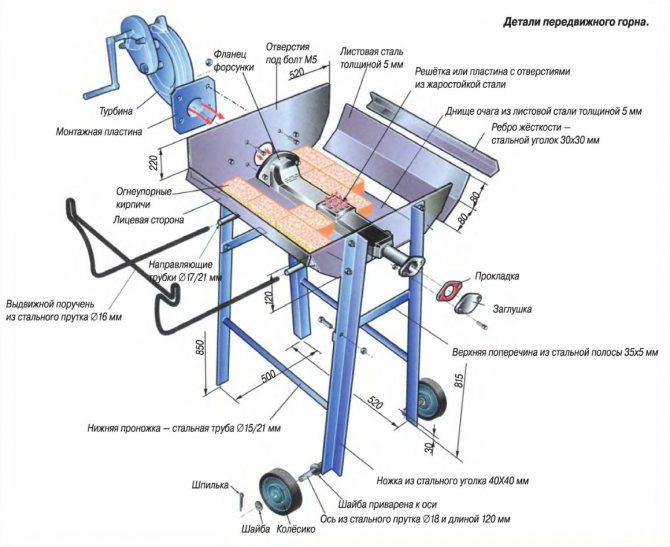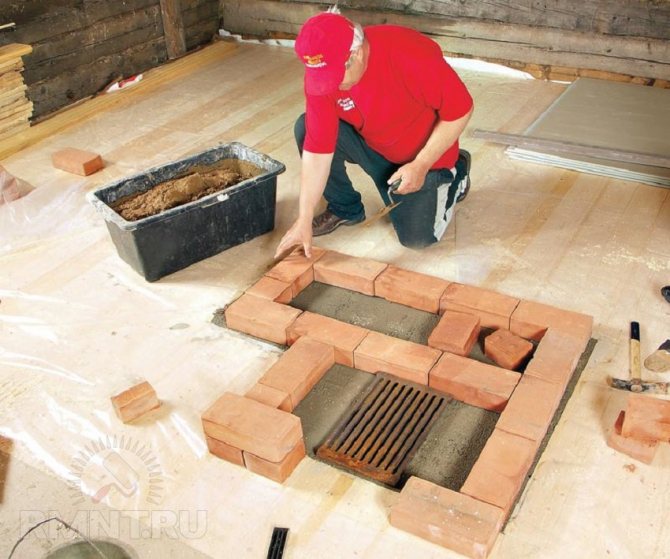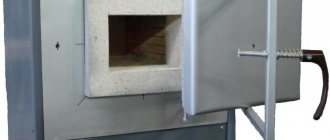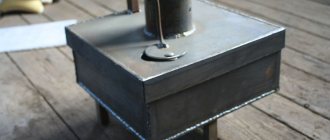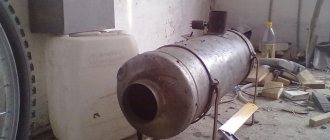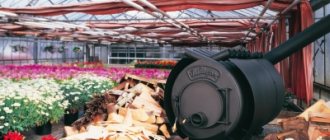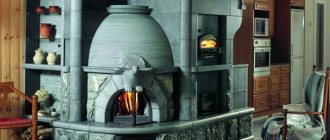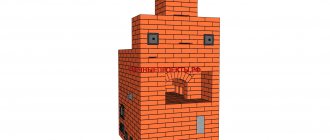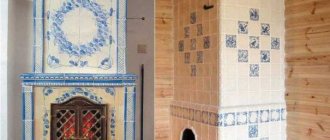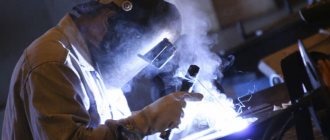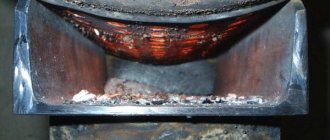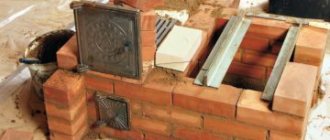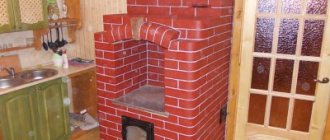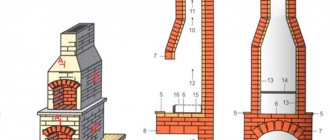Sometimes situations arise when it is necessary, without significant material costs, to heat a small room (garage, workshop or warehouse) as efficiently and quickly as possible. An excellent solution to the problem will be a compact do-it-yourself stove, which requires ingenuity, desire, tools and metal to create.
A simple potbelly stove can be built from materials that are at hand. You can use a regular can or a thick-walled barrel. Many years of practice have shown that very thick metal (over 8 mm) is too difficult to warm up. Thus, efficiency decreases and most of the heat is not used for heating.
If the metal turns out to be too thin, under the influence of high temperatures, it will begin to deform and quickly lose its original shape. The best option is walls of about 3-4 mm.
Rectangular potbelly stove with reflector
When deciding what shape and size a finished potbelly stove should take, everyone must independently. A person with engineering education and skills can take any, even the simplest design, and make the desired changes aimed at improving it.
Drawing of a rectangular potbelly stove:
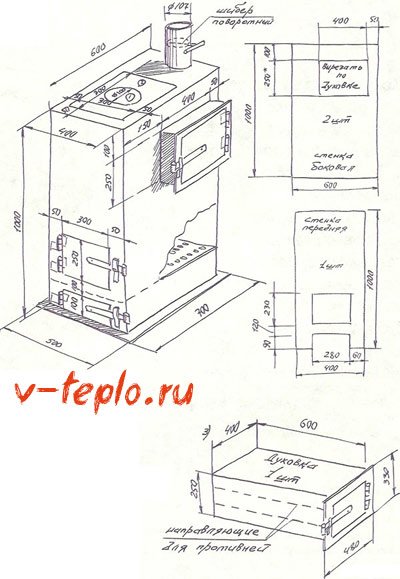
A simple and multifunctional do-it-yourself stove is made from the following materials:
- Outline and simple design drawing showing all basic dimensions
- Sheet metal (its quantity depends on the desired dimensions of the furnace)
- Steel corners (thickness 4-5 mm)
- Metal tube 25-30 mm
- Pipe 180 mm
- Welding machine
- Working hand and electric tool
The furnace body will be made in the form of a rectangle with steel sheets, which are butt-welded to each other. It is necessary to cut the workpieces under five main planes (bottom, top, side and back walls). On the front panel there will be a blower and a door for the furnace, so it will be possible to resolve the issue with it later.
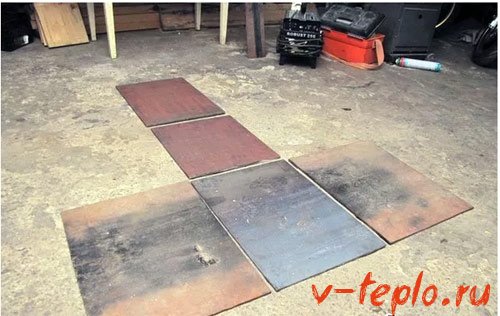

First, the side surfaces are welded to the bottom. It is necessary to ensure that they are located strictly vertically, using a level or square, and docked at a right angle. Having grabbed in 2-3 places, once again we are convinced of the correctness of their location and cook.
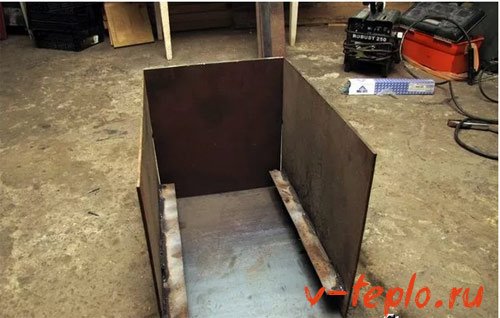

After that, the back wall is welded. All internal space must be divided into three parts:
Recommended reading: an article on how to make a pyrolysis boiler yourself
The last two must be separated by a grate, on which solid fuel (peat, firewood) will be laid. It is done as follows:
- From the inside on the sides at a certain height (10-15 cm), the corners are welded to the entire length
- For the lattice, it is necessary to prepare strips of thick sheet steel with a width of 25-30 mm and a length corresponding to the width of the stove
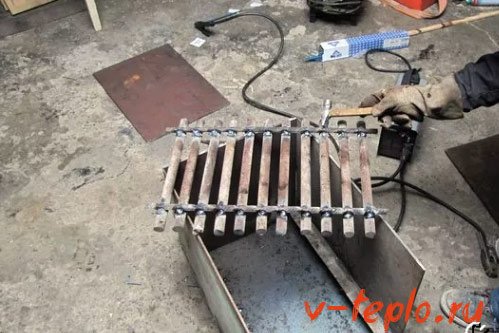

- The distance between the plates is about 5 cm
- Strips are welded to two metal rods with a diameter of 15-20 mm as reliably as possible, since they have another role to play - stiffeners
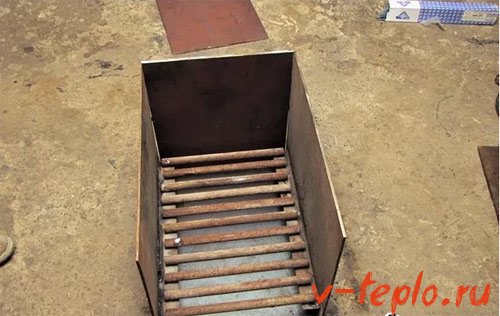

There is no need to weld the grille to the inner corners. If necessary (cleaning the stove, repair), it can be easily obtained. After some time, some of the plates may burn out and will need to be replaced. There are many more reasons to leave the grille removable.
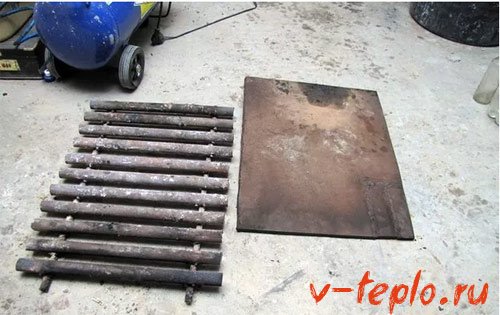

In the next step, you need to weld two metal rods on top, on which the reflector will be located. The latter is a metal sheet that separates the smoke flow and the firebox. The reflector is removable.
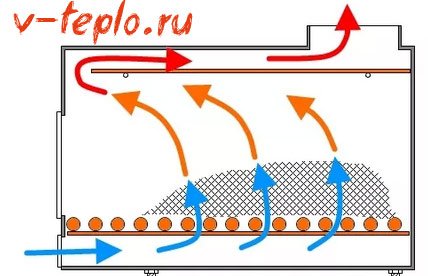

It is necessary to position the reflector so that a channel is formed in front, allowing the smoke to escape. It will warm up inside the most, so it is made of very thick metal (12-16 mm).
It's time to start the final stages of work. First, the future stove cover is welded. It will not be superfluous to provide an opening for the chimney in advance. Then the upper lintel is cut and welded, then a narrower one, placed at the level of the grate and separating the doors of the grate and ash pan.
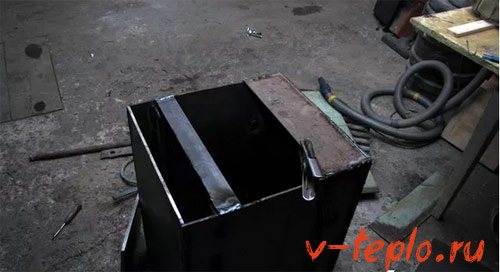

You should not bother much about the size of the doors. The main thing is that it is convenient to lay firewood through them and remove ash and ash. The door for the firebox is made, as a rule, almost the entire width, so that the reflector and grate can be removed, for the ash pan - narrower.
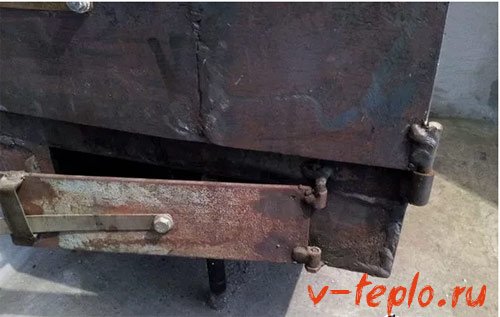

Next, you need to weld the handles for the doors for the stove, latches and curtains. The latter are recommended to be made by yourself from a thick rod and a steel tube. Such work should not be difficult.
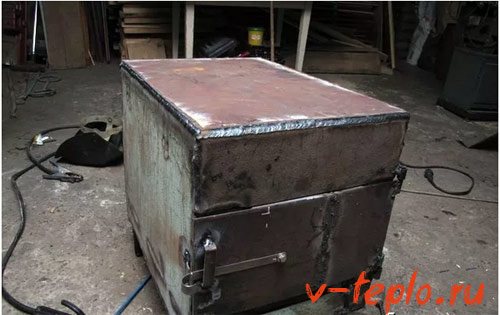

Having collected everything together, it is time to think about how to install the finished structure on the legs. They are recommended to be made of a metal tube 2-3 cm in diameter and 8-10 cm in length with a nut welded at the end and a screwed in bolt. This will allow you to adjust the height. To many, such a step may seem strange, but during the installation process, everything will become clear.
It's time to think about the chimney, which will be made of a pipe with a diameter of 15-18 cm. At the same time, it should be led out through a hole in the wall. Bends are made at an angle of 45 degrees, there should be no horizontal sections.
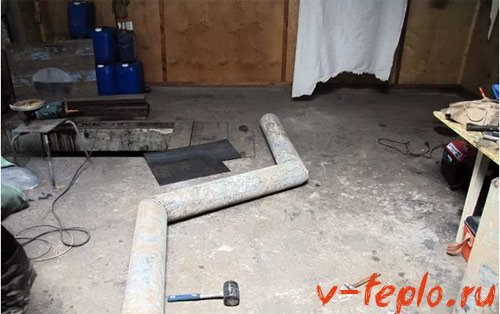

A rotary damper must be provided at the lower end of the chimney. For it, a circle is cut out of sheet metal, with a diameter slightly less than the similar characteristic of the pipe, in which a hole is drilled for the handle for rotation. The latter can be made from a metal bar.
It is necessary to place the chimney on a sleeve 15-20 cm high. It is made from a product with a diameter slightly smaller than the chimney and is welded along the hole to the top cover. It's time to install the stove, adjust the height and that's it - you can heat the room.
Perhaps you will also be interested in an article on how to implement alternative heating of a private house.
How to make a blowing for a forge forge with your own hands
The forge is the main tool in the forge, but to create the required fuel temperature in it, you will need to blow for the forge. There are many models of fans on sale, but they are very expensive, so we will consider an option on how to do it, blowing for the forge with our own hands. This option is more economical and requires a minimum of time.
Parts and tools
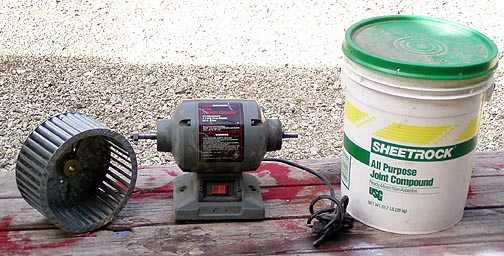

To create it, you need the following details:
- Electrical engine.
- Impeller (you can take it from a centrifugal fan or make it yourself).
- 2 plastic buckets.
- PVC pipe.
Of the tools you will need:
- Screwdriver or screwdriver.
- Drill.
- Knife or hacksaw for cutting holes.
Working wheel
First, let's make the impeller. The wheel itself consists of blades that are fastened together, and in the middle of the wheel there should be a hub for mounting the engine. A circle made of any material (wood, plastic, etc.) is suitable as a wheel. The blades can be cut from stainless steel of the required diameter and attached to the circle in any convenient way. For ease of the manufacturing process, you may need a dimensional drawing. Here is a rough draft:
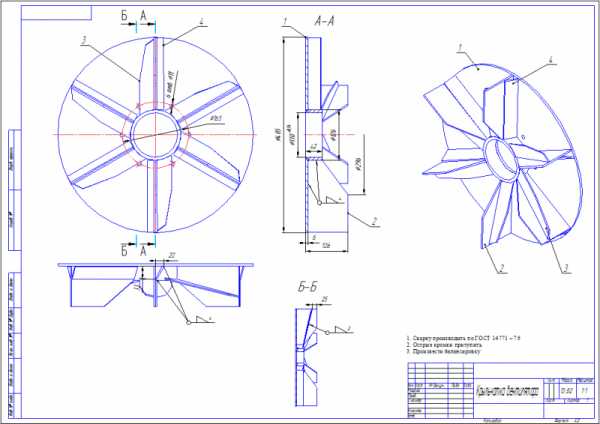

This is what a homemade fan looks like, although the number of blades and the size may be different.
The impeller is ready, now go to the body. The fan will be in the shape of a snail, so the blowing is often called a snail for a forge.
Housing
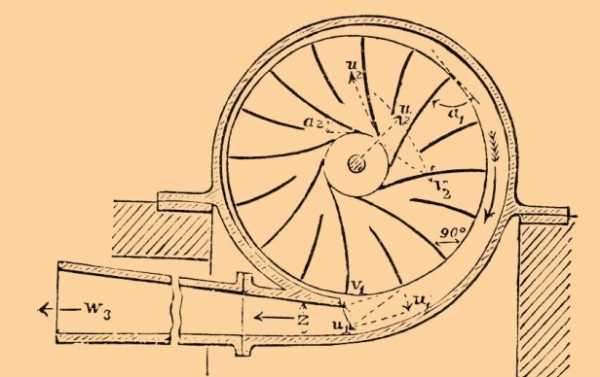

This is how the snail blowing looks like in the diagram.To make it, at the bottom of the bucket, in the center we make a hole, which should be slightly larger than the diameter of the motor shaft. Then you need to make mounts, as in the photo or any other mounts that will securely fix the motor so that it does not rotate and does not touch the impeller.
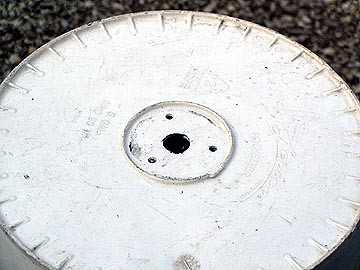

After that, it is necessary to cut the bucket so that it is wider than the impeller. Next, we cut off the cover, the same diameter as the bucket, and in it we make a circle in the center, which will be slightly smaller than the diameter inside the impeller.
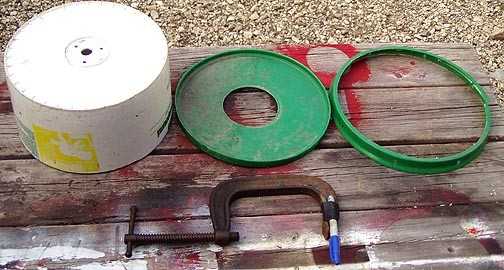

Air outlet
Now you need to make an outlet for air. To do this, we take a pipe, cut it to the desired size and cut it tangentially into the body. Attach the pipe easily with epoxy.
Before installing the pipe, it is important to pay attention to where the air flow from the wheel will be directed and in the same direction to install the pipe. An exception can only be if on the motors, you can change the direction of the air.
Blower installation
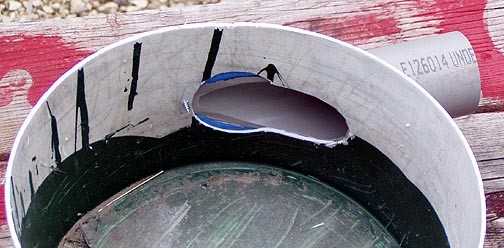

We pass to the final stage - the installation of the blower. We attach the first part with a pipe to the engine. Here you should pay attention to the fasteners so that they are reliable. Next, we install the impeller in this part and close it all with a lid. The latter is also fastened with epoxy resin. For a more presentable look, you can paint the structure in a solid color. As a result, the snail construction should look like this:
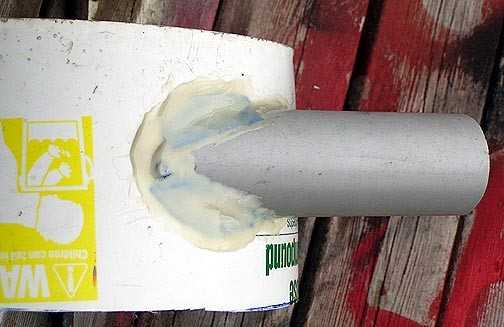

Now the fan for the forge's forge is ready and it remains only to attach it to the forge itself and check the efficiency of the product.
This type of blowing for the ash pan is most preferable, since the air flow can be directed in the desired direction.
kladempech.ru
Simple potbelly stove from a can
The simplest do-it-yourself potbelly stove is made from an ordinary can. There is no need to talk about the durability of such a structure, but it is quickly built, easy to install and gives enough heat.
All work consists in the installation of the legs, the arrangement of the outlet pipe and some cosmetic operations. To work you need:
- Can
- Chimney pipe
- Grate wire
- Welding machine
- Tools
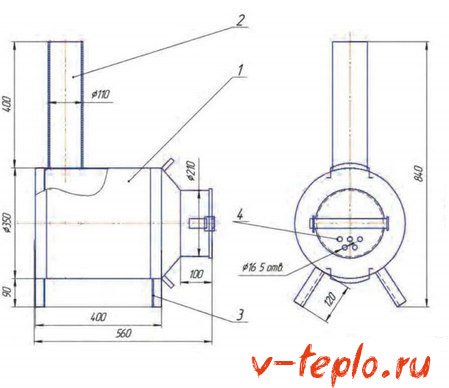

Getting Started
- We set the can horizontally and mark where the blower will be, which has the shape of a rectangle or a sickle. Place it under the lid
- A hole is cut in the wall or bottom of the can, equal to the diameter of the chimney pipe
- To make a grate, you need to stock up on steel wire. It is bent, carried through the lid into the inside and gently unbent so that the zigzag is in the desired position, while it remains convenient to lay chips, firewood, etc.
- The can must be fixed on legs that are cut from tubes or corners and welded
- The chimney is welded
Materials and tools
To create a potbelly stove you will need: • metal with a thickness of 3 ± 0.5 mm: thinner sheets will quickly burn out, in addition, under the influence of high temperature they can be driven, and the furnace will become shapeless; thick-walled metal will warm up for a very long time; • chimney pipe; • rods 16 mm; • a sheet of metal with a thickness of 0.3 mm for the installation of a box for collecting ash; • tape measure, ruler, chalk; • welding machine 140-200A; • grinder for metal cutting; it is more convenient to use a gas cutter to make round holes; • metal brush for cleaning welding spots; • emery wheel for adjusting the doors; • drill and drills.
Burzhuik schemes
The main advantage of a rectangular stove
, unlike oval products made of pipes or gas cylinders, it consists in a larger area of the heated surface, so its efficiency will be much higher. The optimal size for a potbelly stove is 800x450x450 mm. A stove of this size does not take up much space and can easily fit even in a small room.
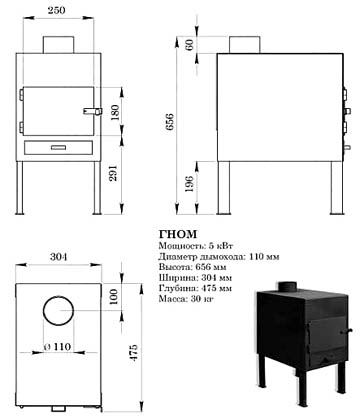

An important distinction Loginov ovens
is the presence of two plates (
reflectors
) at the top of the combustion chamber. As
gas path
at the same time, it increases, the heat transfer of such a potbelly stove is significantly higher than that of a conventional metal stove.
Advice
... If it is required to reduce the size of the Loginov oven, then it is desirable to change only its width. With a change in the length and height of the structure, its effectiveness can be significantly reduced.
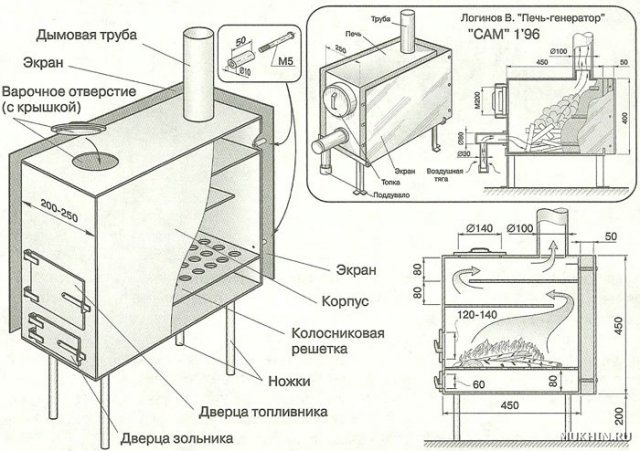

Detailed diagram of Loginov's stove
The main stages of making a potbelly stove
1. All the details are marked on a sheet of metal: 6 steel rectangles for the walls of the furnace, 1 rectangle for creating a smoke reflector, a plate for a grate and a latch for a door. 2. Cut out
a sheet of metal is possible at any metal warehouse. The guillotine, in contrast to the grinder, allows you to cut (chop) it more accurately. In this case, straightening (aligning the sheets) will not have to be done. 3. The furnace body is made in the form of a rectangle. Their sides are joined together at an angle of 90 ° and welded together.
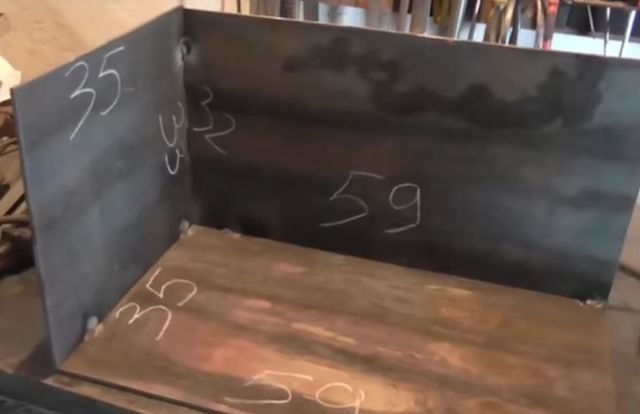

Box welding
4. To avoid mistakes, the box for the furnace is first only tacked by welding in several places, and only then, after checking its horizontal and vertical, its seams are welded.
Important!
All connections in the housing are carefully welded;
to check the seams
for tightness, you can coat the joints with chalk or kerosene.
5. Welding seams are cleaned with a wire brush. 6. The inner space of the stove is divided into three parts: a firebox, a smoke chamber and an ash pan. To separate the firebox from the ash pan, a grate is laid between them, on which the fuel will be placed. To do this, at a height of 10-15 cm from the bottom of the furnace, from the sides and on the back of the box are welded corners 5x5 cm
on which the lattice will be located.
Advice.
It is better to make a grate from 2-3 detachable parts. Otherwise, when replacing a burnt grate, it will be difficult to get it out of the firebox.
7. The grating is welded from thick steel bars or strips 30 mm wide. They are attached to 2 stiffeners - rods with a diameter of 20 mm. Since the grates burn out over time, it is better to make such a grate removable.
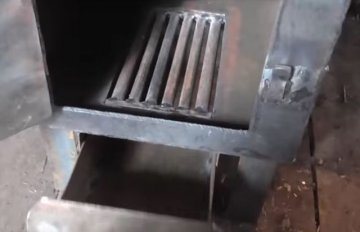

Manufacturing of a grate
8. At a distance of 15 cm from the top of the box, two strong rods are welded, on which it will be stirred one or two removable reflectors
- thick-walled metal sheets, which will trap the flow of hot gases and send them for afterburning. However, they should not completely cover the oven. In order for hot smoke to enter the chimney, an indent of about 8 cm is made from the front (for the first sheet) and the back of the stove.
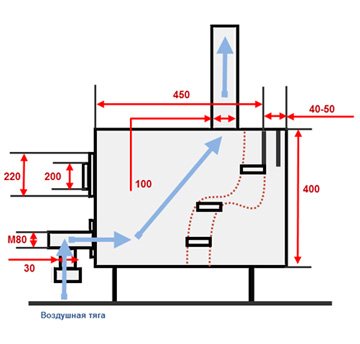

Diagram of the passage of gases in the simplest potbelly stove and oven with a reflector installed
9. Next, the upper part of the box is welded, and then cut out in it pipe hole
.
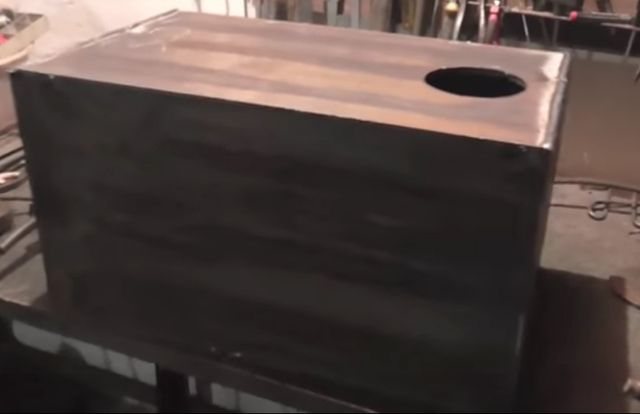

Pipe hole
10. The front part of the stove with holes cut in it for the doors of the firebox and ash pan, is welded last. 11. The size of the door of the firebox must be large enough to be able to load fuel and change the grate without effort. The hole for the ash pan is made slightly smaller. 12. The hinges are welded first to the door and then to the stove body. They can be bought ready-made or welded from two tubes of different diameters. Door handles can be made from a strip of metal or a bar.
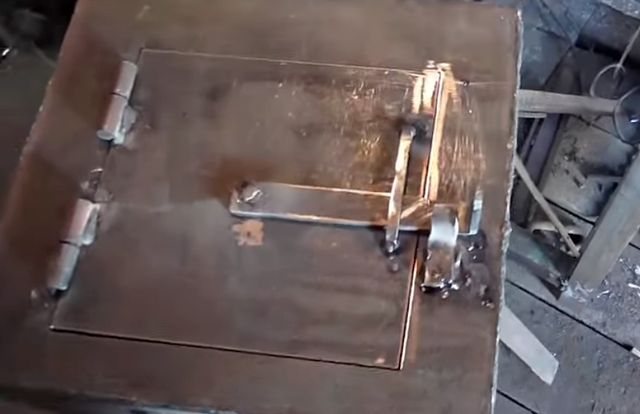

Welding the door
Important!
When attaching the doors,
fit them to the body
as tightly as possible; for this, they are straightened (leveling) and cleaned with an emery wheel. The wedge latches that close the doors fit as tightly as possible to the body.
13. This oven can be used to cook food or warm water. For this, a hole of the required diameter is cut in the upper part of the box. Oven burner
that will fit into this hole can be purchased at any hardware store. 14. For ease of use, the design
installed on legs
or a welded pipe stand. 15. The chimney is connected to the stove
using a sleeve
. 16.
For inserting a damper
regulating the smoke outlet, two holes are drilled in the pipe. The metal rod is inserted into the holes and bent 90 °. A "penny" made of metal is grabbed to it in the center of the pipe - a gate, the diameter of which should be slightly less than the diameter of the pipe itself by 3-4 mm.
Advantages of Utemark Dutch round ovens in a metal case
- Fast heating and slow cooling of the solid brickwork
- Sufficient heat capacity
- Small size
- Installation without foundation
- Long service life and reliability
- Fast assembly of the round furnace frame
- Light weight of building materials upon delivery
- Low cost
- Maintainability
If your old round oven in the frame does not work, then it is not necessary to completely disassemble it. Sometimes it is enough to clean it and move the bricks in the firebox. Replace the door with a modern one. Install an additional cleaning door. Regarding the repair of round furnaces in a case In St. Petersburg and Leningrad region, write to the mail or immediately call.
How many materials are needed for an oven with a diameter of 650 mm and a height of 2300 mm:
- Oven case.
- Solid brick 100 pcs.
- Fireclay bricks 120 pcs.
- Baking mixture 7 bags.
- Refractory mix 8 bags.
- Grate 1 pc.
- Cleaning door 1 pc.
- Furnace door.
- Gate valve.
This is what one of the options for a stainless steel casing kit looks like. The approximate cost is 25,000 rubles from the manufacturer. Such a casing does not require painting - it is already beautiful.
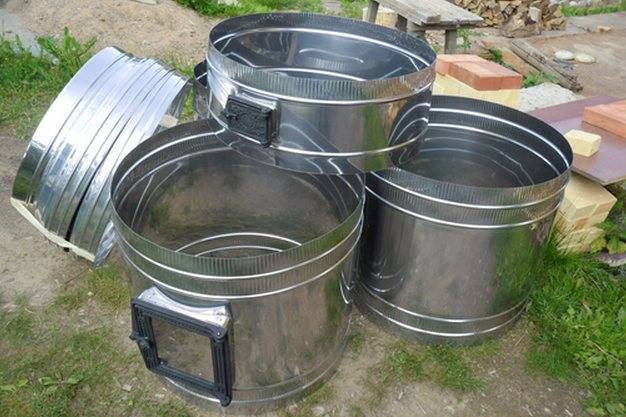

Orders (drawings) of a round stove in a casing designed by V.E. Grum-Grzhimailo.
Drawings of a small heat-absorbing brick oven for self-laying PTO-2500 Download
If you need to repair such a stove or install a new round stove in the casing, call the technician. Phone in the section Works are carried out in Vyborg, Priozersk, Tikhvin, Vsevolozhsk, Sosnovo, Sestroretsk, Lisiy Nos, Zelenogorsk.
Chimney device
• To prevent precious heat from escaping too quickly through the pipe, it must be specially designed. Such a device has two main parts: vertical
height from 1.2 m, installed at an angle of 90 ° above the oven and an inclined part, called
hog
, 2.5-4.5 m long or more, in which the smoke burns out. It is the boar that gives up to 1/4 of the heat of the entire furnace.
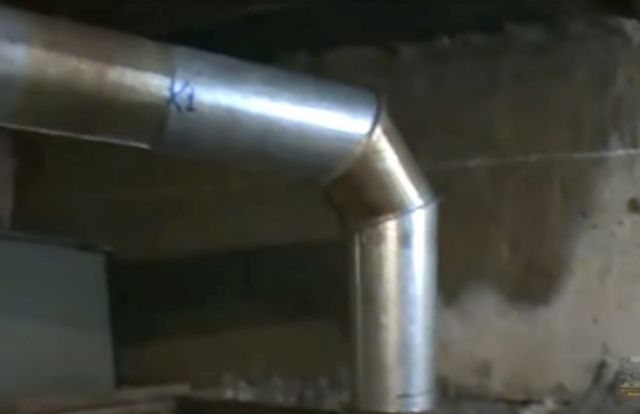

Chimney hogs
• A tall person can touch a heated pipe, so the hog must have a protective cover in the form of a mesh. To avoid burns, the distance from the floor to this pipe should be 2.2 m. The vertical part of the pipe coming from the oven is additionally wrapped with thermal insulation.
Important!
The pipe should be located at a distance of 1.2 m from the plastered walls. The distance from the wooden structures is 1.5 m.
Advice.
Laying a pipe through a wooden ceiling and roof is a rather laborious process. It is much easier to bring it out through a hole in a wall or window.
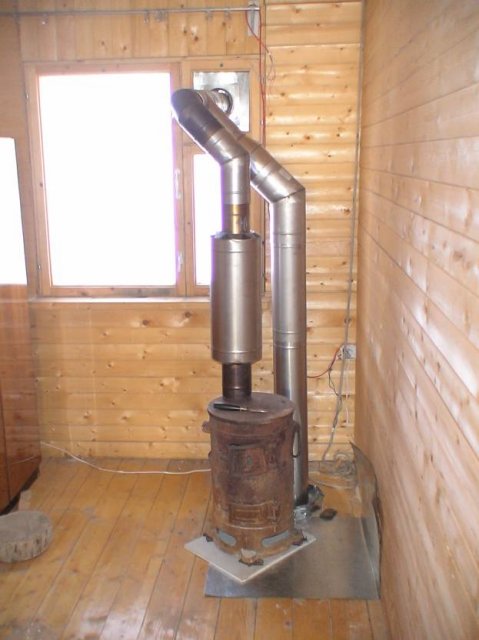

Smoke output through the window
Round oven in a metal casing Dutch or Utemark oven
Customers often have a question, what is the correct name for such ovens. Many call them the Dutch round oven. This is not entirely true. Since all brick heating stoves, faced with tiles from Holland at the time of Peter the Great, were called Dutch.
Another name for round casing ovens is the Utemark oven. Dutch stoves began to be called Uthermark ones after in 1820 Joan Heinrich Utemark, a stove master, official and architect, improved the Dutch stove, proposing to cover it with sheet iron and arrange an air chamber inside. The stove was thin-walled, only a quarter of a brick, quickly heated the room and did not let smoke through the cracks in the masonry.
Rules for the safe installation of a metal oven
The potbelly stove heats up much more strongly than a brick oven, so all flammable objects should be at a sufficient distance from the oven. If the floor in the room is wooden, it is installed only on bricks or metal sheet. The metal, in turn, is laid on a sheet of asbestos with a removal of it 35 cm or more from the edges of the stove. In front of the firebox, it should protrude 5.5 cm. Asbestos can be replaced with felt soaked in clay. It is also possible to install such a screen to reflect heat on concrete.
Important!
A working oven requires supervision. You should not be away from the room for a long time, where the stove is heated.
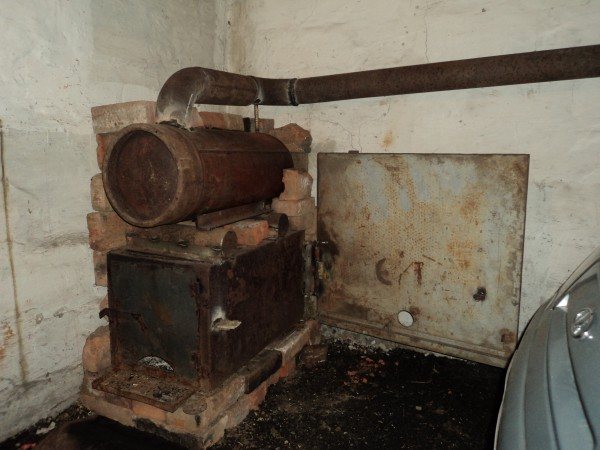

Installing a potbelly stove on a brick base
Furnace fuels
The most common stove fuels are:
- Coal - in the recent past, the most popular type of heating oil in domestic use. Due to the ability of coal to smolder for a long time, the furnace cools down slowly after using it. The main disadvantages of coal are its significant weight, as well as its non-environmental friendliness;
- Firewood is an excellent material for the initial ignition of the stove, but firewood is not suitable for prolonged heating. They burn out very quickly and the stove cools down instantly.
- Peat is a fairly cheap fuel, but its efficiency indicators are small;
- Gas is the most popular fuel for furnaces. It does not require any effort to melt the furnace, it can be used in different modes.
Many modern stoves are designed in such a way that they can be fired with a variety of fuels.
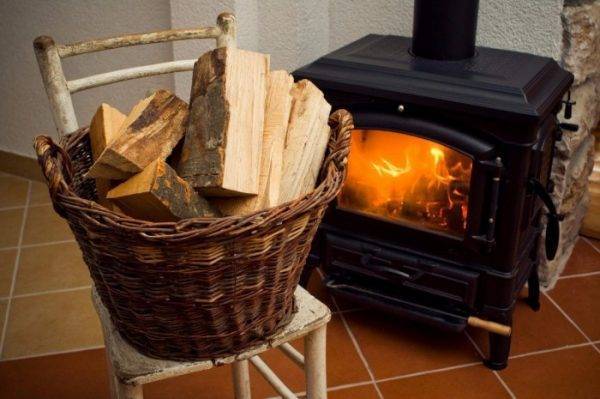

In conclusion, it is worth noting that the stove in the country can be an excellent assistant for both cooking and heating the room in the cold season.
We increase the efficiency of the furnace
The potbelly stove is able to heat the room in just a matter of minutes. Moreover, everything that comes to hand can be thrown into the firebox: since there is no branched network of chimneys in it, and the smoke comes out “directly” in it, there is no need to fear that they will clog up.
But if an ordinary heating stove, installed in premises for permanent residence, has an extensive network of chimneys that trap heat, in a stove it goes directly into the pipe, so its efficiency is not too high. That is why it is too "gluttonous" and requires a lot of fuel.
To reduce fuel consumption, you can use the following tips from experienced stove-makers: • door to the firebox and blew
in such a furnace should be as tight as possible; otherwise, the air supply to the stove will increase, and the fuel will burn out too quickly; • to regulate the output of warm smoke in the chimney
it is desirable to provide a damper
; • near the stove can be provided
side metal screens
at a distance of 5-6 cm from the stove, in which case it will heat the room not only by radiating heat, but also by convection (circulation of warm air); • a potbelly stove, "dressed" in a metal casing, will help keep the heat much longer;
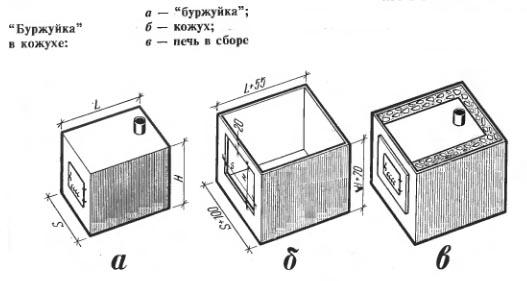

Potbelly stove in a casing
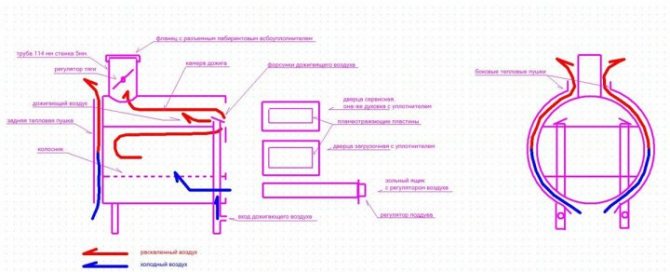

Round furnace with afterburner and casing with heat gun
• to retain heat in the room, bends should be built up in the pipe; however, soot will linger in them, so it is advisable to create a collapsible structure; • the pipe can also be given a stepped shape: arrange the elbows in stages, with each step turning by 30 °; in addition, each of the knees must be securely attached to the wall with rods;
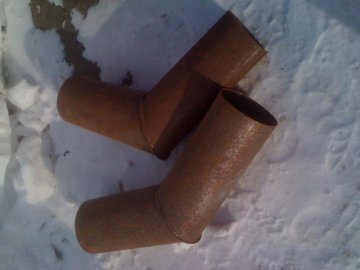

Stove with chimney elbows
• chimney throughput
should be less than the capacity of the furnace itself, in which case the hot gases will not go into the pipe immediately; its diameter should be only 2.7 times larger than the volume of the furnace, for example, with a volume of the furnace of 40 liters, the diameter should be 110 mm; • you can increase the efficiency of the furnace and using
chimney blowing with a fan
- this will turn the oven into a kind of smoke cannon; • to reduce air circulation
firewood in the oven
should fit as tightly as possible; if it is heated with coal, stir up the resulting ash as rarely as possible; • to regulate the air flow, the door to the blower can be made adjustable by equipping it with vertically arranged
slots and latch
which will cover these gaps; • to increase the heating area, it can be ribbed, that is, welded onto its body perpendicular to the furnace
metal stripes
; • if you put steam on the stove
buckets or metal box with sand
, then they will accumulate heat and store it even after the oven goes out;
sand filling or heat accumulator made of stones
can be sewn up inside the metal body of the furnace;
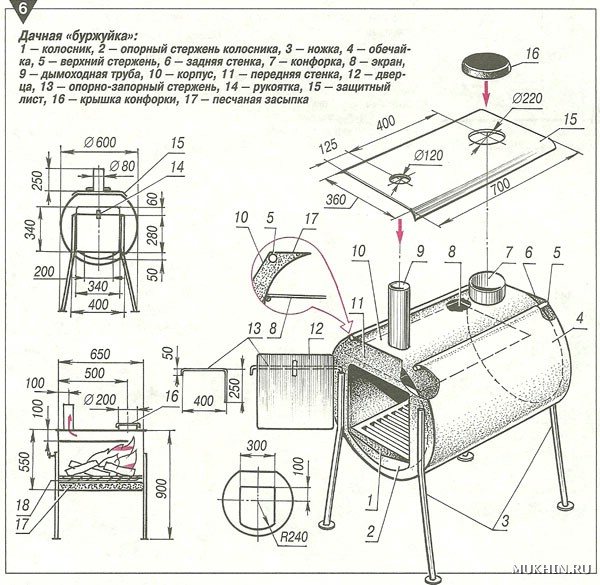

The scheme of a potbelly stove with a sand backfill, the furnace is made of a pipe with a diameter of 500 mm, its length is 650 mm
• bake, lined with 1-2 layers of brick
, will keep warm for much longer;
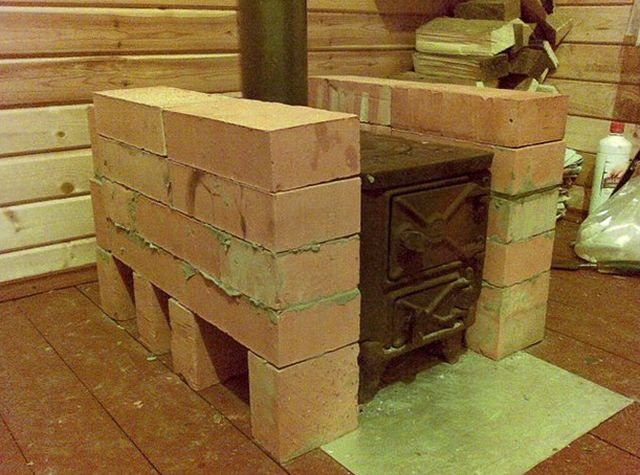

Brick screen
• the volume of the furnace also matters: the more the area of its walls
, the more heat they will give into the room; •
bricks or sheet metal
, on which the stove is installed, will help not only to protect the room from fire, but also to keep warm.
Related video: Do-it-yourself stove stove
From my own experience, I know that buying even the simplest heating stove can deal a serious blow to the budget of an ordinary person. Having studied the many available designs of stoves, I decided to give preference to Buleryan. A homemade modification of a well-known foreign heating stove perfectly took root in my garage.


Do-it-yourself buleryan stove - drawings and assembly diagram
Advice
All work is easy to perform with practical experience. Beginners can make the process easier with the advice of the professionals:
- Purchasing pre-fabricated stainless steel components is a forward-thinking decision. But for welding such a coating, special welding electrodes will be required.
- To prevent the pipe or cylinder from rolling during operation, the legs or stops are temporarily welded.
- For the free flow of smoke into the chimney, at least 1/3 of the diameter of the stove is required.
- If there are welds based on them, they are placed in the lower part. This will reduce the effect of heat on weak points in the structure.
- The outer walls of the chimney are insulated with mineral wool. It reduces the impact on the surrounding objects and protects the metal from corrosion.
- The boiler is filled with water before firing up to avoid burns and heatstroke.
- When decorating the furnace, only refractory paint is used. Other types quickly deteriorate from high temperatures.
- If possible, the oven is faced with brick, leaving free space for the doors. The cladding will provide an even distribution of heat and its preservation for a long time.


Knowing how to build the most effective do-it-yourself sauna stove, it will be easy to put this into practice using step-by-step instructions with drawings and photos. Homemade stoves are almost as good as factory models, but they cost significantly less. If you are interested in the material, share your opinion and results in the comments.
Similar publications
- To read
Wood-fired sauna stoves with a water tank: features and photos
- To read
DIY brick barbecue
- To read
DIY pizza oven
- To read
Facing the oven with ceramic tiles with your own hands
- To read
Laying a stove with a stove step by step with your own hands
- To read
Furnace Crafting Kit
First, I prepared everything I needed to assemble buleryan with my own hands. First of all, I took out a drill from the pantry with a set of drills for all occasions, a grinder with discs from the kit, a welding machine, clamps and other little things.
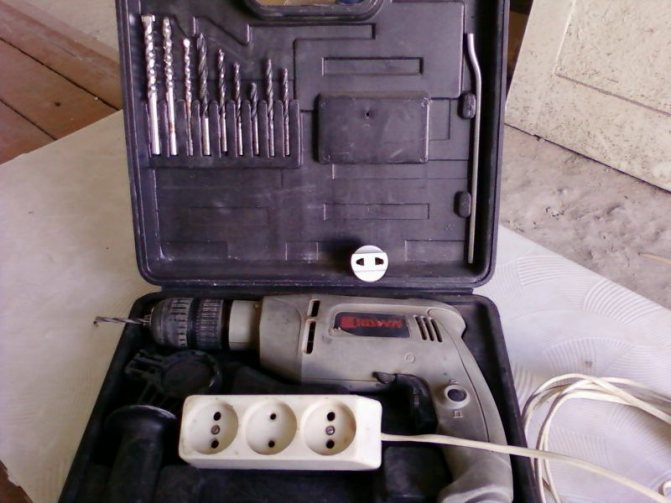

My drill
I had to tinker with the materials. To make Buleryan truly reliable and of high quality, I decided to make it from heat-resistant boiler steel. This material is able to ensure a truly long-term and reliable operation of the heating unit.Find the material mentioned in your household or buy it from a specialized store.
I also used 4mm steel sheet. A sheet with dimensions of 100x200 cm was enough for me. In addition, I needed a little (40x70 cm) of 6 mm steel sheet, about 4 meters of pipe with a diameter of 11 cm, about 10 m of profiled pipe with dimensions of 57x4 mm. In addition, I bought handles, hinges and locks for arranging the doors, prepared pieces of a 35-centimeter pipe and, in general, several metal blanks just in case.
Prices for popular models of welding machines
How I modernized Buleryan
The features of the device of the stove in question are such that it can initially qualitatively and evenly distribute oxygen within itself. The tubes draw in cold oxygen from the bottom, and heated air is discharged from the ones installed at the top. If desired, you can provide forced circulation of oxygen.
I took tubes of a suitable diameter and welded adapters from them to the holes of the stove pipe located below. I plugged the adapter off one edge.
I connected the other side with a fan.
I decided to use "snail" fan models. To ensure their work, in my case, a 90-watt engine at 2800 rpm was enough.
The results are excellent - after the modification, Buleryan began to work even more efficiently.
I am also thinking about connecting the corrugation to the upper outlets and spreading it in different directions - you will get a full-fledged heating system.
You can think of the instructions in your own way. I would love to read your suggestions and maybe even put something into practice.
My instructions will help you to assemble a reliable, efficient, durable and productive stove with your own hands.
Video - Do-it-yourself Buleryan oven
Did you like the article? Save so as not to lose!
- 5
- 4
- 3
- 2
- 1
5
Vladimir Pechurin.
Made buleryan according to your recommendations. The result was stunning. To say that this is a good oven is to say nothing. The oven is great. Thank you for the article.
Vladimir Pechurin.
Made the oven according to the recommendations of the author of the article. To say that the oven is good is to say nothing. She's just wonderful! I have never met anything better.
Evgeny
We did not try to consider the profile square pipe.


